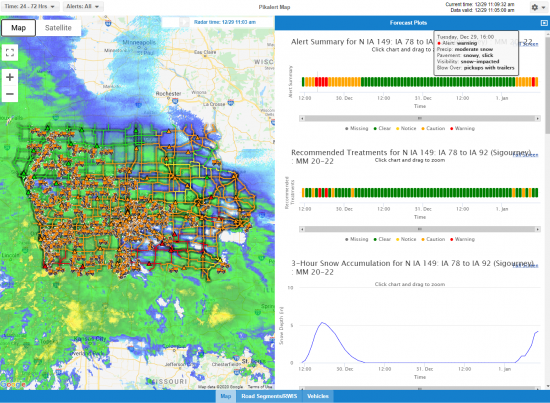InTrans / Dec 29, 2020
Noteworthy Practices: Iowa Department of Transportation
Pikalert
About 15 percent of the 264,453 crashes in Iowa over the past five years have occurred during some kind of inclement weather, from fog to blowing snow to this year’s unexpected derecho. Of those, about half of the incidents occurred during winter weather.
That’s why it’s critical for the Iowa Department of Transportation (DOT) and local agencies to be able to better predict and prepare for winter weather events and other potential roadway hazards. In addition to the implementation of road weather information systems (RWIS) across the state, the Iowa DOT is also evaluating the use of a new system called Pikalert, which provides weather forecasts for each DOT roadway up to 72 hours into the future and includes alerts and treatment recommendations.
Researchers at the Institute for Transportation’s Real-Time Analytics of Transportation Data (REACTOR) Lab have been supporting the Iowa DOTs evaluation of the Pikalert system, along with the National Center for Atmospheric Research (NCAR) who are the developers of the system.
Tina Greenfield, Iowa DOT RWIS coordinator, said the agency is expanding its user-base to include all maintenance staff in its second year of using Pikalert. The Iowa DOT will also explore ways the data can ultimately be condensed and shared on public platforms, such as 511.
“Right now, the data is very detailed, and we’re looking into ‘at-a-glance’ ways of boiling down into simple messages,” Greenfield said.
The Pikalert system assesses current weather and road conditions based on observations from road weather information stations, radar, and weather model analysis fields and forecasts future conditions up to 72 hours by utilizing information from weather models. The system has the capability to include data from the DOT snowplow fleet which is equipped with AVL and forward facing cameras.
“We’re working with Iowa DOT staff to identify how this demonstration tool might be integrated into daily operational use,” said Neal Hawkins, principal investigator on the Pikalert project and InTrans associate director. “With the web-based Pikalert tool in place, we anticipate our focus this winter will be on providing system support, analyzing Pikalert performance and accuracy, getting user feedback, and making minor enhancements to the interface.”
The Pikalert work is part of an overarching project to support the Iowa DOT Cooperative Automated Transportation (CAT) research, applications, data analytics, demonstrations, and discovery. The Pikalert system grew out of an effort by the U.S. DOT’s Federal Highway Administration (FHWA) and Research and Innovative Technology Administration (RITA) to promote safety, mobility, and improve the environment of the nation’s surface transportation system through a connected vehicle initiative.

